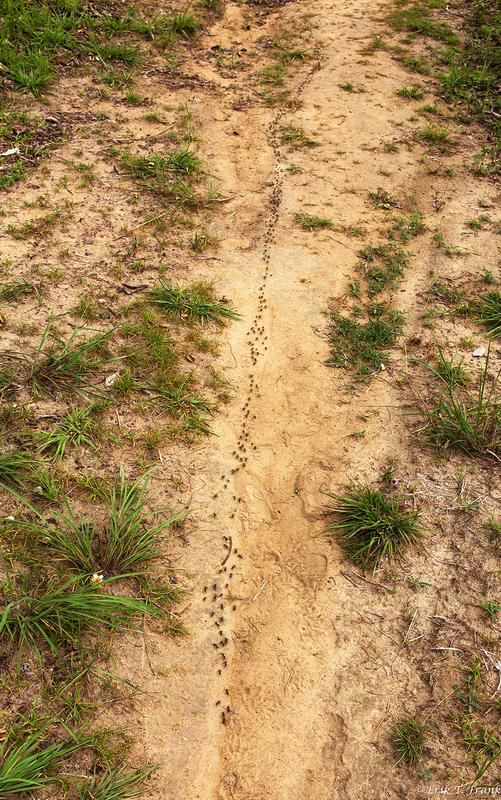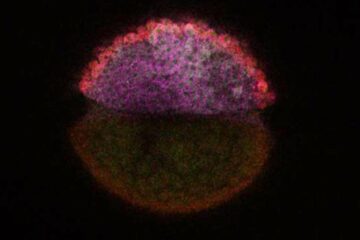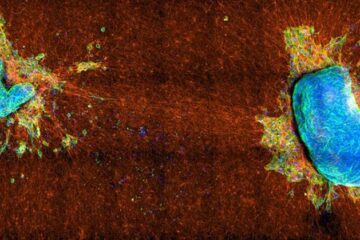Matabele ants: Travelling faster with detours

Matabele ants on a raid: They take detours through open terrain to speed up their journey. (Photo: Erik Frank)
Termites are the African Matabele ants' (Megaponera analis) favourite dish. Proceeding in long files of 200 to 600, they raid termites at their foraging sites and haul the prey back to their nest where they are ultimately eaten.
Before starting their raids, the ants send out scouts to look for the termites' foraging sites. Once they have spotted them, the scout ants return to the nest to mobilize their comrades. On their way back to the nest, the scouts show astonishing navigational abilities: They take the quickest route rather than the shortest.
Travelling faster in open country
If the direct way back passes through an area densely grown with grass, for example, the scouts prefer taking detours through open terrain which enables them to double their pace – and this is worth it: They travel much faster although they are not taking the shortest route. This reduces their time back to the nest by 35 percent on average as Erik T. Frank, Philipp Hönle, and Karl Eduard Linsenmair from Julius-Maximilians-Universität Würzburg (JMU) in Bavaria, Germany, discovered. The biologists' results have been published in the Journal of Experimental Biology.
Individual ants make decisions
“Other ant species are known to rely on various navigational aids to determine the shortest way back to the nest from a foraging site,” Erik Franks says. The navigational skills of the Matabele ants seem to be even more complex, a finding the researchers want to explore in greater detail now.
Moreover, the JMU scientists were surprised that the decision which way to take is made by individual ants and not collectively. “We have thus provided the first proof of time optimized path integration by individuals in the ant kingdom,” says Frank who is currently conducting postdoc research at the University of Lausanne.
Publication
Time optimized path-choice in the termite hunting ant Megaponera analis. Erik T. Frank, Philipp O. Hönle, K. Eduard Linsenmair. Journal of Experimental Biology 2018, 10 May. DOI: 10.1242/jeb.174854
Contact
Dr. Erik T. Frank, University of Lausanne, Department of Ecology and Evolution, T +41 21 692 4176, erik.frank@unil.ch
http://jeb.biologists.org/content/early/2018/05/09/jeb.174854 Link to the paper
Media Contact
All latest news from the category: Life Sciences and Chemistry
Articles and reports from the Life Sciences and chemistry area deal with applied and basic research into modern biology, chemistry and human medicine.
Valuable information can be found on a range of life sciences fields including bacteriology, biochemistry, bionics, bioinformatics, biophysics, biotechnology, genetics, geobotany, human biology, marine biology, microbiology, molecular biology, cellular biology, zoology, bioinorganic chemistry, microchemistry and environmental chemistry.
Newest articles

Decoding development: mRNA’s role in embryo formation
A new study at Hebrew University reveals insights into mRNA regulation during embryonic development. The study combines single-cell RNA-Seq and metabolic labeling in zebrafish embryos, distinguishing between newly-transcribed and pre-existing…

Study sheds light on cancer cell ‘tug-of-war’
How cancer cells tug against each other determines whether they can migrate elsewhere in the body. Understanding how cancerous cells spread from a primary tumor is important for any number…

Latest generation of self-dissolving stents
Magnesium implants support coronary arteries and keep them open. Constricted coronary arteries harbor dangers: Because the heart is not supplied with blood properly, this can lead to pain, cardiac arrhythmia,…





















